40 position time graph to velocity time graph worksheet
Consider the position vs. time graph below for cyclists A and B. a. How does the motion of the cyclist A in this graph compare to that of A in the previous graph? Worksheet for Exploration 2.1: Compare Position vs. Time and Velocity vs. Time Graphs Shown are three different animations, each with... (a) Explain how you can use the graph of position versus time in Figure 9 to describe the change in velocity over time. Identify: (b) the time ( t a , t b , t c , t d , or t e ) at which the instantaneous velocity is greatest, (c) the time at which it …
Velocity Time Graph Worksheet. Смотреть позже. Поделиться.
Position time graph to velocity time graph worksheet
We know that velocity is equal to displacement over change in time. We have a graph (velocity vs time) showing an object traveling at a velocity of 20m/s for 2 seconds. So how do we find displacement or distance traveled? We can find the area under the line. This should be justified by the velocity formula so we can do 20m/s = (x/2s) and we get 40m as our answer. Now here’s the problem. At zero seconds, the velocity is zero. At one second, the velocity is 10. At two seconds, the velocity i... Graphing Velocity as a Function of Time. Earlier, we examined graph s of position versus time . Figure 2.15 A graph of position versus time for the drive to and from school is shown. We assumed for our original calculation that your parent drove with a constant velocity to and from school. Position-Time Graph Students refer to the position-time graph to answer questions about the movement of an object. ID: 1456010 Language: English School subject: Physics Grade/level: 11 Age: 14+ Main content: Kinematics Other contents: Distance-Time graph, velocity, distance, displacement.
Position time graph to velocity time graph worksheet. Graphing position, velocity, and acceleration versus time is a good choice since the rise and fall and shape of a graph are analogous to the changes in these quantities. In this lab, we'll create position and velocity graphs of an object with constant velocity. The acceleration of the object is 0.28 m/s. I know how to graph this on a velocity vs time chart, but I can't figure out the equation for a position vs time graph. So far I have come up with the idea that y=x\^1.28. What would the equation be? Side note: I’m new to reddit and I can’t figure out how to add a picture to my post so please bear with me My question asks to find the velocity of an object swinging back and forth at 0.6 seconds on the graph. The graph shows it’s displacement to the right of its initial staring point (0cm) is 8cm at 0.3 seconds before it pauses for 0.1 seconds and swings the other way to -4cm from 0.4-0.8 seconds where it doesn’t pause and swings the other way to 0 where the graph ends. If you're going backward from velocity-time to position-time, you have to take the anti-derivative of the graphs, it's bascially just working backward; finding the position graph whose derivative would make the velocity-time graph you are looking at. It's a little more difficult to do that way.
Having trouble with this last problem, and I just can't figure it out. Well, it's 2 sub-problems. (f) What is the final position *x* of the object at *t* = 18 s? (g) Through what total distance has the object moved between *t* = 0 and *t* = 18 s? [https://s.yimg.com/tr/i/797e44a7c1474084bfec7b6982ae281d\_A.png](https://s.yimg.com/tr/i/797e44a7c1474084bfec7b6982ae281d_A.png) (this is the graph for the problem) So I tried 0 for f, but that didn't work. How do I go about solving these? If the position-time data for such a car were graphed, then the resulting graph would look like the graph at the right. Note that a motion described as a constant, positive velocity results in a line of constant and positive slope when plotted as a position-time graph. Position time graph for constant velocity. In physics, the displacement or change in position of an object with regards to time (w.r.t.) is often shown in a graphical form. These position time graphs give us a visual representation of an objects motion which makes it much easier to understand. [https://imgur.com/a/whsLAO5](https://imgur.com/a/whsLAO5) For question 11 b, just from looking at the graph I thought it'd be 8 seconds, the textbook says its 10 seconds - what am i doing wrong here? not sure if its any help but i calculated the area under graphs when t=8, After 8 s, the bus has travelled 56 m and the bike 64 m.
If you look at the velocity time graph from 0-2, seco… You can go on to confirm the remaining trip matches that of B by calculating the 2-4 seconds of the velocity time graph area between the x-axis and graph as -40m (negative because area is under the x-axis). Velocity - Time Graphs. Last Updated : 20 May, 2021. Anything that contains Kinetic energy is in some type of motion, whether it is one-dimensional Velocity-Time graph is very important while learning about the motion of any object, the graph tells about the acceleration of the object. Since the velocity is constant, the displacement-time graph will always be straight, the velocity-time graph will always be horizontal, and the acceleration-time graph will always lie on the horizontal axis.When velocity is positive, the displacement-time graph should have a positive slope. When velocity is negative, the displacement-time graph should have a negative slope. The time between two position points and . is . Elapsed time for an event is , where . is the final time and . is the initial time. The initial time is often taken to be zero. Average velocity is defined as displacement divided by elapsed time. If . and . are two position time points, the average velocity between these points is
Oct 07, 2021 · Position vs time graph worksheet answer key. Students will graph 18 equations written in slope-intercept form. So that we attempted to identify some great 21 stained glass transformations worksheet answer key graphic for you. This visualkinesthetic project will help students to clearly identify the equations of horizontal and. Consumer math ...
I understand that one can estimate the displacement on this type of graph but I was wondering if there is any possible way to find the exact displacement. Thanks for all the help
The acceleration time graph is the graph that is used to determine the change in velocity in the given interval of the time. In the acceleration vs time graph on the x-axis you have the time taken by the object and on the y-axis acceleration of the object, in which the area under the graph gives you the change in velocity of the object over the given period of the time.
Hence Position vs time graph slope gives the velocity of the object. x-t graph for uniformly accelerated motion. A distance-time graph will tell you the distance covered, that is the exact length of the actual path used to travel from the initial point to the final point, with respect to time.
As the title states I had a problem on my [physics homework](http://imgur.com/gallery/iWsFkxI) that we were never actually taught how to solve. I eventually threw in the towel and took the hit on points just so I could see the answer and now I'm not sure I know how they got it. I'm assuming there are integrals involved and I tried those numerous times but I have to assume I'm doing something wrong here because I never got 100 m/s The problem asks for the velocity at t = 6.5 s when the partic...
Position-Time Graphs Velocity-Time Graphs. Using graphs to describe motion. The line. To begin, consider a car moving with a constant, rightward (+) velocity.
Velocity-time graphs. Get the Gizmo ready: ●Click the red Reset button on the stopwatch. ●Change the Number of Points to 5. ●Turn off Show graph and In the Gizmo, make the position-time graphs shown below. Click the green Start button and watch the runners run. Hand draw in this space or click...
Velocity vs. Time Graphs. There's lots of useful information that we can get from a graph. For example, the slope on a position graph tells us the Take out the "more practice with position and velocity graphs" worksheet. On the back, shade in the area on each velocity graph that represents...
Learn more. Position from a Velocity-Time graph [closed]. Ask Question. You can't "simply" calculate the average velocity from the velocity at the end points, unless the velocity graph is a straight line.
I'm trying to wonder the motion of each line and I would appreciate any help in clarifying. So if I had 4 lines and 4 graphs how would each line look? Line 1: Uniform velocity on a distance time graph Line 2: Constant velocity on a distance time graph Line 3: Uniform acceleration on a velocity time graph Line 4: Constant acceleration on a velocity time graph I know how a few of the lines look but I sometimes get confused in remembering the difference.
Forces and Motion. Position - time graph and velocity. Physics Narrative for 14-16. Accumulations set the connection between graphs. Physics is all about noticing, and then reusing, common patterns. You got a handle on velocity-time graphs by thinking about acceleration as the quantity which told...
Theory: The change in position (d) divided by the time it takes to change that position (t) is the average velocity. 8 cm v = ! d /! t Example: If it takes 2 s to go the 8 cm, then, v = 8 cm/2 s = 4 cm/s The change in velocity (v) divided by the time it takes to change that position (t) is the average velocity. a = ! v/! t = vf - vi tf - ti
From a particle's velocity-time graph, its average velocity can be found by calculating the total area under the graph and then dividing it by the corresponding time-interval. For a particle with uniform acceleration, velocity-time graph is a straight line.
Worksheet Constant Velocity: Position-Time Graphs #1. Printer Friendly Version. Match the description provided about the behavior of a cart along a linear track to its best graphical representation. Remember that velocity is determined by examining the slope of a position-time...
I figured out how to get the velocity in respect to x but want to essentially shift the x axis so that it represents time. Say your main function is x^3+6. I also found the equation for finding time is the length of a curve integral divided by the x acceleration that I found. V=(Sqrt (2g(f(0)-f(x)). I'm bad at calc so pls help me integrate the two equations into each other.
Q. Every morning, Tom walks along a straight road from his home to the bus stop. Below, is a graph representing Tom’s trip to school. What is the average speed of Tom’s journey throughout the first segment, which is between 0 seconds, and 50 seconds?
(a) Focus on the slope of the graph, as in Figure 2.8, which represents the velocity. The position-versus-time graph is a straight line for the first 40 seconds, so the slope, and the velocity, is constant over that time interval. Because of …
Similarly, the acceleration-time graph is derived from the velocity-time graph. The slopes of each graph relate to the various graphical representations The position-time graph describes the motion of an object over a period of time. Time in seconds is conventionally plotted on the x-axis and the...
Position-Time and Velocity-Time. Graphs Questions for Consideration What is a position-time graph? Traveling in negative direction, but slowing down. Position-Time Graphs The slope of a P-T graph is equal to the objects velocity in that segment. time (s) p o s i t i o n.
By graphing the position, velocity, and speed as functions of time, we can understand these concepts visually (Figure). In (a), the graph shows the particle moving in the positive direction until t = 0.5 s, when it reverses direction. The reversal of direction can also be seen in (b) at 0.5 s where the...
Draw the velocity vs time graphs for an object whose motion produced the position vs time graphs shown below at left. 8. For many graphs, both the slope of the line and the area between the line and the horizontal axis have physical meanings.
Name Date Pd Unit 1.3 Constant Velocity Worksheet 3 1. For each of the below data tables: Use Graphical Analysis to create a graph Do not Print or save anything!! Velocity (m/s) Position (m) 2. For the following Position-time graphs create the appropriate velocity-time graph. ©Modeling...
A rock climber stands on top of a 50m high cliff overhanging a pool of water. He throws two stones vertically downward 1.0s apart and observes that they cause a single splash. The initial speed of the first stone was 2.0m/s. How long after the first stone does the second stone hit the water? My problem Iam having is that I get the correct answer as per book, but I want to check my answer to see if it is correct. I draw a velocity-vs-time graph and calculate the area with the formula of the fin...
[link](https://i.imgur.com/Jk32HEm.png?1) What does this question even mean?
I'm going to be doing a math project. It seems that the f1 subscription gives you it, but I wanted to make sure. Thanks
Sketch a position-time graph of each object listed below. Describe its slope as positive or negative, and as constant, increasing, or decreasing. 6 Finding Instantaneous Velocity from a Graph (Non-Uniform Motion) To find instantaneous velocity on a non-uniform position-time graph, draw a line...
We can graph Jill’s position versus time as a useful aid to see the motion; the graph is shown in Figure 3.5. Figure 3.5 This graph depicts Jill’s position versus time. The average velocity is the slope of a line connecting the initial and final points. Significance
I'm just teaching myself from a high school textbook. I know on a linear graph instantaneous velocity equals average velocity. But I'm having trouble since the graph is curved. I'm working with the following table: position (m[forward]) = 0.0 when time(s) = 0.0, position = 2.0 when time = 1.0, position = 8.0 when time = 2.0, position = 18.0 when time = 3.0, position = 32.0 when time = 4.0, position = 50.0 when time = 5.0 Sorry if this table is confusing. I couldn't figure out a better way to r...
Look up Graphical Integration. It is a technique that can be used to integrate from the graph only with no explicit formulæ. You'll now have a table of the approximate position versus time. What you've done is used a graphical numerical method to integrate your velocity versus time graph (which.
GCSE (1 - 9). Velocity Time Graphs. Instructions. • Use black ink or ball-point pen. • You must show all your working out. Information. • The marks for each question are shown in brackets - use this as a guide as to how much time to spend on each question.
Position Time Graph - Understand all about Position Time graph, Calculation of avg. velocity with other graphs in detail & prepare for the JEE Main The average velocity of a moving object from a position-time graph can be calculated easily. Average velocity is equal to the change in position...
A worksheet that requires the pupils to construct their own graphs of motion, and answers questions about them. A harder question at the end to stretch the higher at. Subject: Force and motion. Age range: 14-16. Resource type: Worksheet/Activity.
Acceleration on a position vs. time graph can be obtained, by having the initial position and velocity of a moving object. In this article, we want to show you how to find constant acceleration from a position-time graph with some solved problems. You can skip this introduction and refer to problems...
animation to the appropriate position-time or velocity-time graph. Once 11 matches have been. A printable worksheet accompanies the resource with conceptual questions and data tables for A Velocity vs. Time graph is simultaneously displayed. Students will analyze the V/T graph to figure...
Position-Time Graph Students refer to the position-time graph to answer questions about the movement of an object. ID: 1456010 Language: English School subject: Physics Grade/level: 11 Age: 14+ Main content: Kinematics Other contents: Distance-Time graph, velocity, distance, displacement.
Graphing Velocity as a Function of Time. Earlier, we examined graph s of position versus time . Figure 2.15 A graph of position versus time for the drive to and from school is shown. We assumed for our original calculation that your parent drove with a constant velocity to and from school.
We know that velocity is equal to displacement over change in time. We have a graph (velocity vs time) showing an object traveling at a velocity of 20m/s for 2 seconds. So how do we find displacement or distance traveled? We can find the area under the line. This should be justified by the velocity formula so we can do 20m/s = (x/2s) and we get 40m as our answer. Now here’s the problem. At zero seconds, the velocity is zero. At one second, the velocity is 10. At two seconds, the velocity i...













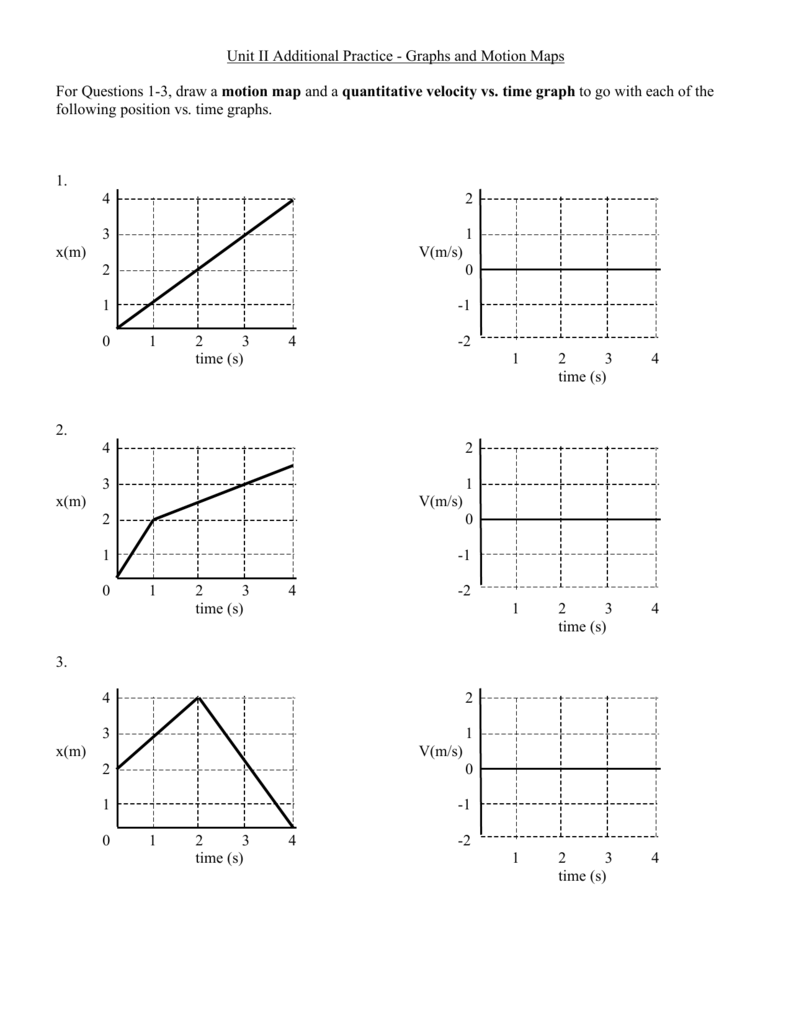


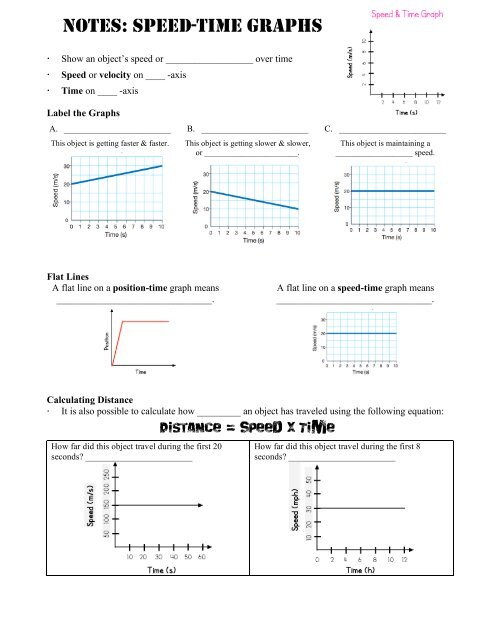

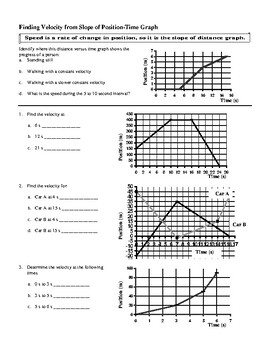
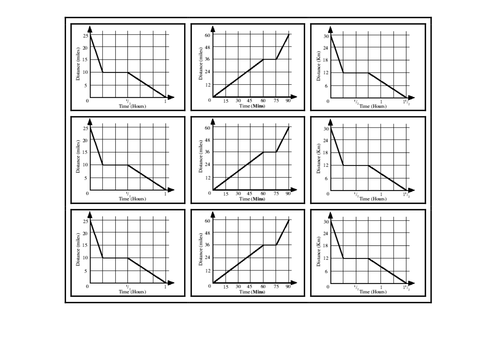



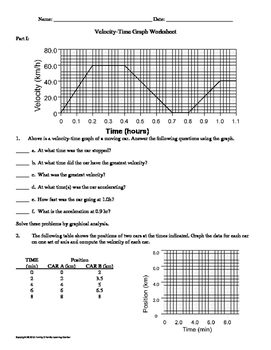

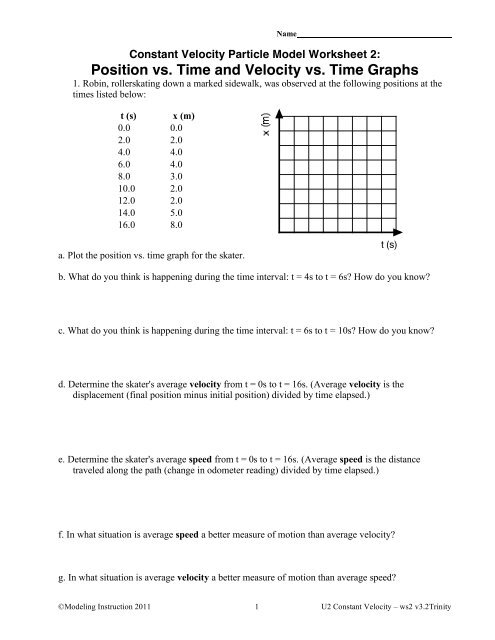


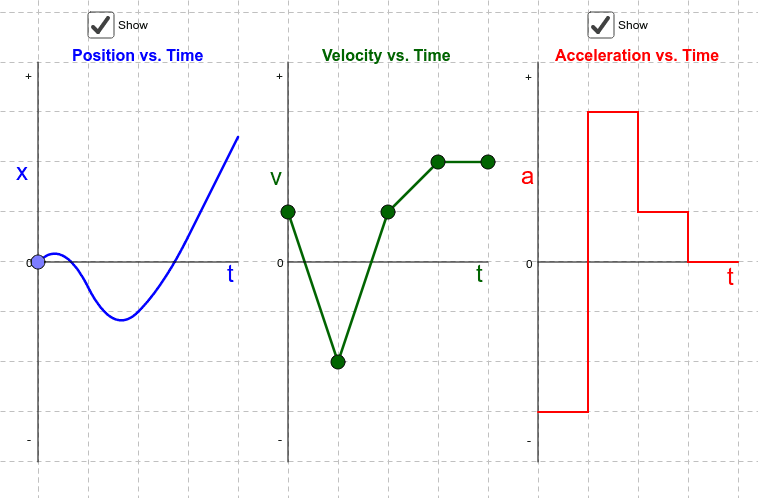


0 Response to "40 position time graph to velocity time graph worksheet"
Post a Comment